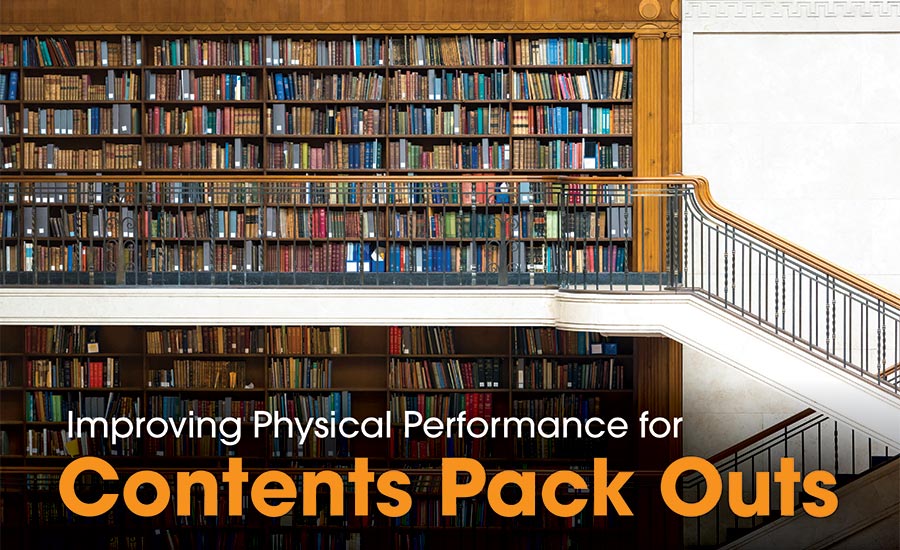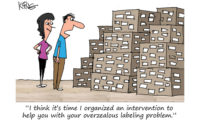No two pack outs are created alike. Imagine packing, loading, and transporting books, archives, and special collections from an academic library post disaster. Think worker output and physical performance.
Behind the Research
The purpose of this study was to find articles available to restoration professionals, in R&R’s search, about (a) manually handling books and (b) improve worker physical performance. Workers are an important part of the content handling process [2-5]. However, there is very limited information on improving their physical performance with this activity.
Research Methodology
This study’s research design consisted of:
- Developing an online survey questionnaire
- Developing questions
- Determining sample population
- Developing a database of email addresses for data collection
- Creating word clouds out of data
- Analyzing word clouds
Human Performance Experts (Survey Respondents)
The online survey questionnaire was distributed to 892 human performance experts in the United States. These experts work at college and university departments and schools, who offer degrees, conduct research projects, and provide curriculum on subject matters related to human performance. There were 160 survey respondents. However, 102 respondents answered all four research questions.
Demographics
The human performance experts included various job roles, highest levels of education, highest earned degrees, and work locations. A large majority of the respondents are professors (See Figure 1). The experts earned a doctoral degree at a high rate (See Figure 2). Further, they studied various subject matters related to human performance (See Figure 3). Figure 4 shows many experts work at colleges and universities, in the Northern and Eastern United States.




The human performance experts were asked to read an introduction statement. Next, they were instructed to read the action description and then review photograph, which is a type of photo elicitation, prior to reading and responding to question.
A field experiment was conducted inside the museum library. How men and women perform this physical activity was one of the purposes for this experiment. Volunteers packed books into boxes, carried them to a temporary location, lowered them to the floor, and returned to bookshelves with empty boxes. This activity continued, until the shelves were empty.
Packing
Action: grabbing books from shelves, using one or two hands, and then placing them into a box (See Figure 5).

Question 1.
What types of exercises should men and women do to improve physical performance for this action?

The human performance expert responses were filtered, combined, and quantified, in which, 11 exercises were generated (See Figure 6). They recommended more upper body exercises for packing compared to transporting and loading. Their responses were one or more words, sentences, or paragraphs, for example:
Professor, Doctoral (Public Health): Squats with proper form (spinal alignment) for bending and picking up the box, and upper body for holding weights.
Transporting
Action: lifting box, and then carrying it to a temporary location. [Typically, men and women will carry boxes from inside the facility to outside the facility. This action can require walking up and down staircases, while carrying box.] (See Figure 7).

Question 2.
What types of exercises should men and women do to improve physical performance for this action?
The human performance expert responses were filtered, combined, and quantified, in which, 10 exercises were generated (See Figure 8). They recommended more cardio exercises for transporting compared to packing and loading. Their responses were one or more words, sentences, or paragraphs, for example:

“Squatting with weights to mimic lifting the box, walking while supporting a similar load, static hold with a similar load, step ups and single-leg squats with some resistance, balancing with a load.”
Loading
Action: lowering box to the floor (See Figure 9).

Question 3.
What types of exercises should men and women do to improve physical performance for this action?
The human performance expert responses were filtered, combined, and quantified, in which, five exercises were generated (See Figure 10). Loading action received fewer exercise recommendations compared to packing and transporting. Their responses were one or more words, sentences, or paragraphs, for example:

“Individuals require adequate ankle and hip mobility for this task, so exercises to address ankle mobility (i.e. eccentric lowering on stairs with knee flexed) and hip mobility (i.e. lunge with anterior reach) would be recommended. Additionally, overhead squat would help develop motor control necessary to correctly perform deep squat and resisted back extension would help with loading tasks.”
Question 4.
Can exercising help men and women improve physical performance for these actions?
The human performance experts were instructed to read and answer question. All the experts answered “Yes.”
Conclusion
The purpose of this study was to find out exercises that will help men and women workers improve physical performance, when they pack, transport, and load books. Human performance experts provided exercises for men and women to perform in order to improve physical performance (See Figures 6, 8, and 10). Lastly, the human performance experts agreed that exercising can help men and women improve physical performance for these actions: packing, transporting, and loading.
General Comments
- The author conducted a field experiment inside a museum library because of the book collection size, layout, and accessibility.
- The volunteers wore a task card around their necks. This task card included the instructions from their training.
- Figures 5, 7, and 9 photographs are screen shots from videos of the field experiment.
References
- Passley, C.E., Determining Differences Between Archival Staff and Restorers Ranking of Training Topics for Disaster Restoration Projects. Collection Management, 2013. 38(4): p. 267-300.
- Jackson, B., Contents: The Future of Restoration. Restoration & Remediation, 2013.
- Coy, A., Ask Annissa: How Should I Hire for my Contents Division? Restoration & Remediation, 2014.
- Street, S. Fast Action Required to Restore Water-Damaged Documents. Restoration & Remediation, 2011.
- Street, S., Restoration Contractors Need a Plan for Document Recovery. Restoration & Remediation, 2019.




Report Abusive Comment